-
PDF
- Split View
-
Views
-
Cite
Cite
Yutaka Kojima, Kazuhiro Sakamoto, Shigeo Horie, Yuichi Tomiki, Masaya Kawai, Yu Okazawa, Yuki Tsuchiya, Kosuke Kitamura, Toshiyuki China, Simultaneous robot-assisted surgery for rectal cancer and prostatic lesions, Journal of Surgical Case Reports, Volume 2020, Issue 9, September 2020, rjaa338, https://doi.org/10.1093/jscr/rjaa338
Close - Share Icon Share
Abstract
Robotic surgery has become prevalent in many departments all over the world because of its usefulness. It is used in many cases, as well as in gastrointestinal surgery, which treats the rectum as pelvic surgery, urology and gynecology. We experienced two cases of joint surgery, with urology as pelvic surgery. The patient underwent robot-assisted low anterior resection, combined prostate resection and ileostomy for prostate invasion of rectal cancer. He was discharged without any complications. Robotic surgery was considered to be useful in surgery to manipulate the same area. In addition, it was considered that smoother and safer surgical procedure could be possible by conducting preoperative meetings with the participating departments.
INTRODUCTION
Pelvic surgery is intended for gastrointestinal surgery, urology, gynecology and multiple departments that deal with pelvic organs, and adjacent organs when surgical treatment is required, and when they are localized to a single department, surgery may be inadequate. Often, simultaneous surgical treatments may be necessary. Thus, the usefulness of simultaneous surgery for multiple organs under laparoscopy has also been reported [1]. Robotic surgery is performed worldwide, and is widely used in digestive surgery, urology and gynecology, which represent departments that deal with the rectum, bladder, prostate, uterus and ovaries among the pelvic organs. In this report, we report a case where we performed combined surgery with urology as pelvic surgery.
CASE PRESENTATION
Case 1 was a 44-year-old man with a BMI of 26.9 kg/m [2], who was diagnosed as having lower rectal cancer with regional lymph node metastasis and direct prostate invasion (T4b, N1, M0 stage IIIc) (Fig. 1). The patient underwent preoperative chemotherapy followed by surgery. We docked da Vinci Xi from the lower left of the patient. The camera port was in the umbilical region, and the left 8 mm port was placed somewhat caudal from the placement of the port for rectal surgery, considering the operation procedure in urology. The surgical procedure involved dissection of the lymph node and blood vessel knot separation according to the normal procedure. Regarding rectal detachment, the posterior and lateral walls of the rectum were exfoliated as passively as possible (Fig. 2a), and the anterior wall was also exfoliated passively to the seminal vesicle position. After removal of the rectum, the oral intestinal tract was dissected with the sigmoid colon. Thereafter, dissection of the bilateral lymph nodes was performed (Fig. 2b), and the operation was transferred to urology. At that time, retargeting was set to the pelvic midline. In the urology department, resection of the prostate was performed (Fig. 2c–e), and a specimen was removed from the perineum. Subsequently, a colostomy was created and the operation was completed. The operation time was 949 min and the blood loss was 290 ml. The tumor was extending almost all around and directly invaded the prostate (Fig. 3). Pathologically, poorly differentiated adenocarcinoma including signet ring cell carcinoma was the main subject. The effect of chemotherapy was grade 0, and no effect was obtained by chemotherapy.
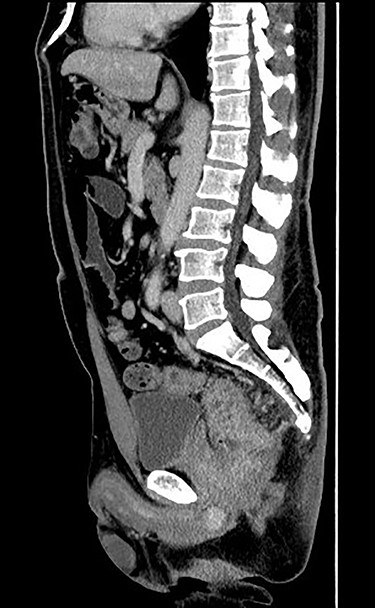
Enhanced computed tomography (CT) scan (sagittal image). Enhanced CT scan showed that the rectal tumor directly invades the prostate.
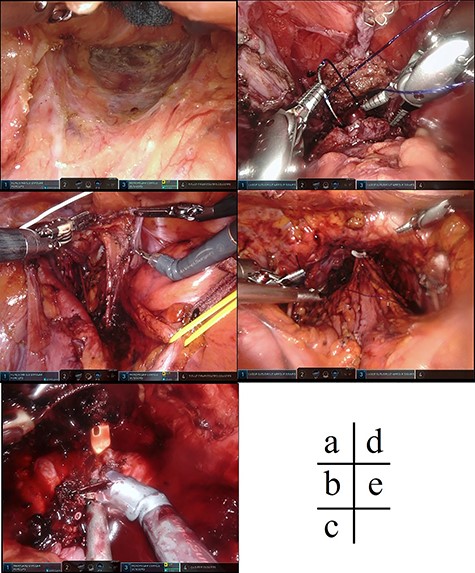
Intraoperative findings. (a) The rectum was detached passively, including the posterior wall of the rectum and the side wall. (b) Dissection of the lateral lymph nodes of the pelvis on both sides was performed. (c) The urethra was dissected and the urinary catheter was inserted during the prostatectomy. (d) A urethral anastomosis was performed after excision of the rectum including the prostate from the anus. (e) After specimen removal and reconstruction of the urinary tract.
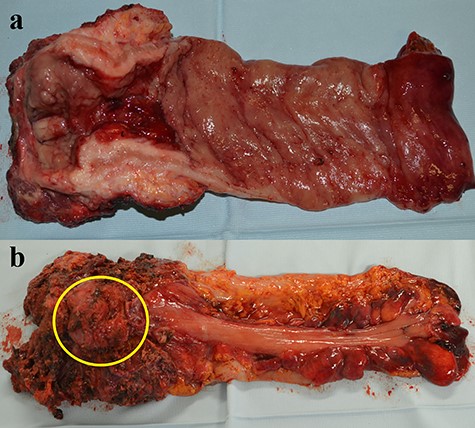
(a) On the mucous membrane side, there was a rectal tumor extending almost all around with a size of 10 cm × 11.5 cm. (b) On the serosa membrane side, a prostate gland that had been resected due to direct infiltration was found in a part of the specimen (yellow circle).
DISCUSSION
Simultaneous laparoscopic surgery for multiple cancers has been reported frequently, and simultaneous surgery with colon cancer is also occasionally used [2, 3]. The safety and validity of the procedure has also been reported in a number of cases [4]. With the spread of robotic surgery, there have also been reports on simultaneous surgery using robotic surgery and laparoscopic surgery, and their usefulness has been reported. On the other hand, the importance of the port arrangement at that time has also been reported [5–7].
When dealing with the pelvic organs, it is considered that surgery can be performed concurrently, taking advantage of the advantages of robotic surgery in each department, as the operation range is performed in almost the same area.
The problems that arise when performing surgery on multiple organs by robot-assisted surgery include (1) operating room, preparation of staff, (2) port arrangement and (3) order of the surgical operation.
In this case, careful discussions and simulations were conducted in advance regarding the preparation of the operating room and staff, and the positions of the assistants, the positions of the nurses in the operating room, and the positions of the energy devices were determined. Roll-in is usually from the crotch during prostate surgery, but from the left caudal side of the patient to allow transanal manipulation during surgery. In addition, the position of the submonitor can be moved because the position differs depending on the department (Fig. 4). As for port placement, the umbilical cord is used as a 12 mm camera port for the rectum along the line passing through the umbilical from the lower right abdomen to the upper left abdomen, and with the port on the left upper abdomen only slightly caudal, Urology It was placed to facilitate surgery. For the rectum, the assist port was placed in the upper right or lower left abdomen, and the assist port for prostate surgery was placed in the upper left abdomen, if necessary. Four shared da Vinci ports reduced the number of required ports (Fig. 5). Robotic surgery requires stricter port restrictions than laparoscopic surgery and stricter settings [2].
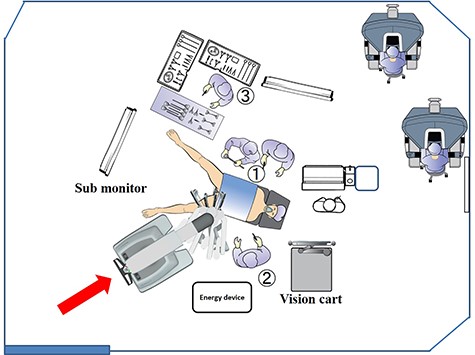
In the surgery and urology departments, the operating room was arranged so that the operation could be performed smoothly and without waste by moving the monitor.
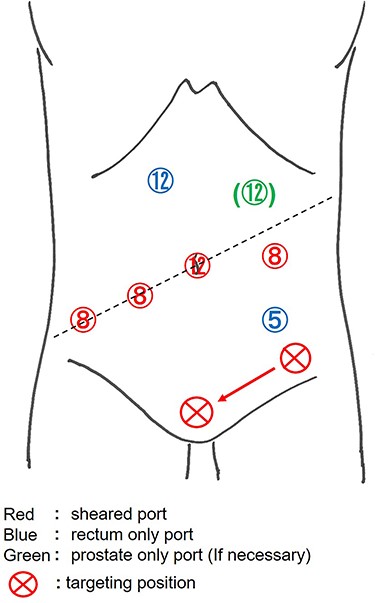
In the surgery and urology departments, as many ports as possible were shared so that they could be shared and utilized.
It is considered that the order of operation varies greatly depending on whether it is necessary to perform an anterior resection on the rectum, an abdominoperineal resection or a combined resection. As in this case, a low anterior resection preceded in patients who did not require combined resection of the rectum and prostate, followed by prostatectomy. The reason for this is that, when operating on the rectum by removing the bladder, there is a concern that the rectum may become difficult to perform surgery on, due to depression of the bladder. However, on the other hand, there have also been reports of RARP being performed first in cases where the robotic and laparoscopic procedures were performed concurrently. This is because the ureter was easily seen on the inner approach and dissection of the ventral aspect of the rectum was not necessary [5].
It is possible to perform safer joint surgery by selecting ports that can be used in common by performing close preoperative meetings and simulations, reducing ports, and reducing the use of surgical equipment, and I believe that through this cooperation I can fully demonstrate the usefulness of robotic surgery.
The usefulness and safety of simultaneous robot surgery have also been reported [8], and the indications for robot-assisted surgery will be further expanded in the future. It is believed that the use of simultaneous surgery will therefore increase. Thus, the further accumulation and examination of such cases will be necessary in the future.
CONFLICT OF INTEREST STATEMENT
None declared.



